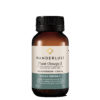Barley grass, also known as nutritional grass or more commonly referred to as cereal grass, is the young green plant that eventually matures into cereal grain. The grass is not the grains of the plant and consequently are gluten free, unlike the barley grain. Barley grass is recognised by its brilliant emerald – green hues.
Before ‘jointing’ (when the seed head forms in the stem of the plant), the plant is known to be at its highest nutrient period, or at the nutritional peak. It is at this time that the shoots are harvested for human consumption, dried at body temperature, and powdered.
The nutrient profiles of green cereal plants change quickly as they grow. As the plant grows, the chlorophyll, protein and vitamin content of cereal grasses declines sharply, and the level of cellulose (indigestible fibre) increases.





